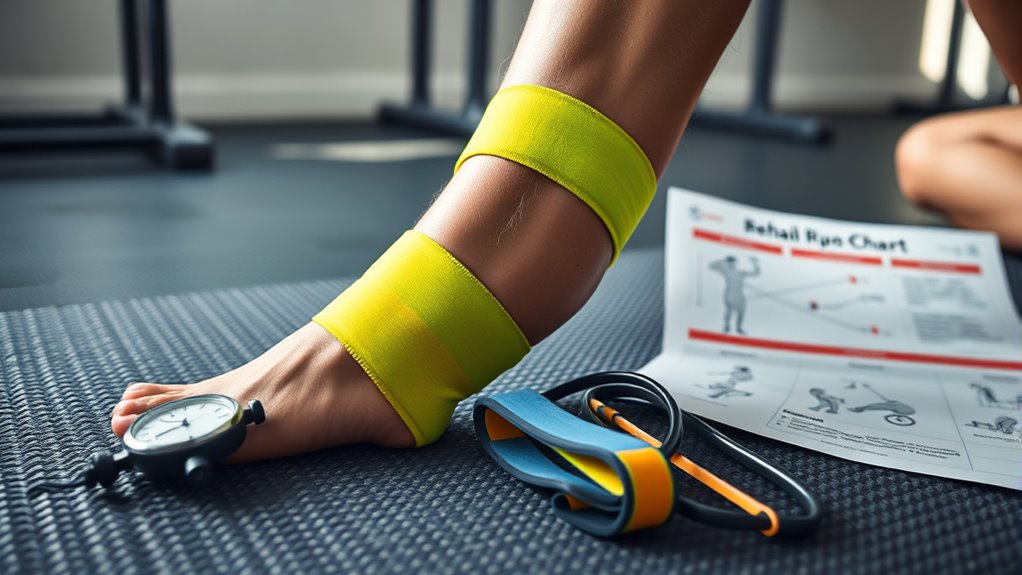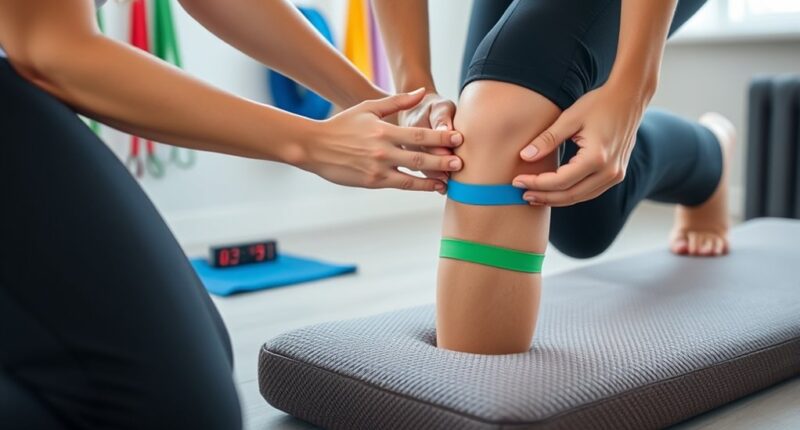To recover from runner’s knee, follow a structured, gradual plan starting with gentle, pain-free exercises like quad and hip abductions, focusing on proper form. Each week, slowly increase activity intensity, incorporate flexibility, and avoid high-impact movements. Pay attention to pain signals and adjust accordingly. Consistency is key for long-term improvement. Keep progressing step-by-step, and you’ll build strength and stability—if you continue exploring, you’ll discover detailed week-by-week tips to optimize your recovery.
Key Takeaways
- Begin with gentle isometric exercises like quad sets and straight-leg raises to activate key muscles without pain.
- Gradually increase exercise repetitions and introduce dynamic movements as tolerated, avoiding high-impact activities early on.
- Prioritize proper form and controlled motions, stopping exercises if sharp or persistent pain occurs.
- Incorporate stretching and flexibility routines once pain subsides to improve range of motion and muscle balance.
- Maintain consistency and patience through gradual progression, fostering long-term recovery and injury prevention.
Rehab Strategies for Runner’s Knee Recovery

If you’re dealing with runner’s knee, a structured rehab protocol can help you recover faster and prevent future injuries. The key to success lies in carefully planning your exercise progression and prioritizing pain management. When you start your rehab, it’s essential to focus on gentle movements that build strength gradually without pushing your knee into discomfort. Initially, you’ll want to incorporate exercises that activate your quadriceps, hip abductors, and core muscles. These exercises should be introduced at a low intensity, emphasizing proper form and controlled motions. As you progress, you’ll slowly increase the intensity and repetitions, always listening to your body and avoiding pain.
Pain management plays a critical role in your recovery process. You should aim to keep your discomfort minimal—if an exercise causes sharp or persistent pain, it’s a sign to back off and reassess. Using ice after activity can help reduce inflammation and alleviate soreness, while avoiding high-impact activities like running or jumping until your knee is ready. Throughout the rehab, focus on maintaining a comfortable baseline of activity that doesn’t exacerbate symptoms. This approach helps you stay active while giving your knee the time it needs to heal.
In the early weeks, your exercise progression might include isometric exercises, such as quad sets or straight-leg raises, performed in a pain-free range. These help strengthen without stressing the joint. As your strength improves, you can introduce more dynamic exercises like mini-squats or step-ups, but only as tolerated. The goal is to build your capacity gradually, avoiding sudden increases in workload that could trigger pain or setbacks.
Consistency is essential. You should stick to your prescribed routine, gradually increasing the challenge as your knee adapts. This steady progression helps you build resilience and reduces the risk of overloading the joint too soon. Incorporate stretching and flexibility exercises to improve your range of motion, but only after your pain subsides and your muscles feel ready. Always prioritize proper technique over intensity; this minimizes unnecessary strain and ensures your rehab is effective. Additionally, understanding muscle activation can help optimize your exercises for better recovery outcomes. Incorporating growth mindset principles can also encourage patience and persistence throughout your rehabilitation journey, leading to better long-term results.
Frequently Asked Questions
How Long Does Full Recovery Typically Take?
Recovery time for runner’s knee varies depending on age, activity level, and injury severity. Usually, it takes about 6 to 12 weeks, but older individuals may experience longer rehabilitation durations due to age-related factors affecting healing. Staying consistent with your rehab exercises, avoiding aggravating activities, and following your physical therapist’s advice can help speed up recovery, though patience is key for a full return to running without pain.
Are There Preventive Exercises to Avoid Recurrence?
Did you know that over 50% of runners experience runner’s knee recurrence? To prevent this, you should incorporate strengthening exercises that target your quads, hips, and glutes. Flexibility drills for your hamstrings, IT band, and calves also help reduce strain on your knee. Consistently doing these exercises keeps your muscles balanced, lowers your risk of injury, and helps guarantee you stay pain-free in the long run.
Can I Return to Running Before Complete Pain Relief?
You might be tempted to return to running before all pain subsides, but it’s best to wait. Focus on early stretching and strengthening exercises to support recovery. Make sure you wear proper footwear to reduce stress on your knee. Rushing back too soon can worsen your condition or cause a setback. Listen to your body and consult your healthcare provider to determine when you’re truly ready to return safely.
What Symptoms Indicate a Need to See a Doctor?
You might think minor discomfort isn’t urgent, but if you notice increased swelling, severe pain, or instability, see a doctor. Don’t ignore symptoms that worsen or persist despite rest. Diagnostic tests help pinpoint the problem, guiding effective treatment options. Early medical advice ensures you get the right care, preventing further injury and ensuring a quicker recovery. Trust your body—if symptoms escalate, seek professional help promptly.
Does Age Affect Recovery Time for Runner’S Knee?
Age impact does influence recovery variation for runner’s knee, meaning your age can affect how quickly you heal. Generally, younger individuals tend to recover faster due to better tissue regeneration, while older people might experience a longer recovery process. However, your overall health, activity level, and adherence to rehab also play vital roles. So, while age is a factor, it’s not the sole determinant of your recovery time.
Conclusion
By following this week-by-week rehab protocol, you’ll steadily regain strength and reduce pain. Stay consistent, listen to your body, and don’t rush the process. Remember, nearly 50% of runners experience runner’s knee at some point, highlighting how common recovery is. With patience and dedication, you can return to your active lifestyle stronger than before. Keep focused, and you’ll be back on the track in no time.









